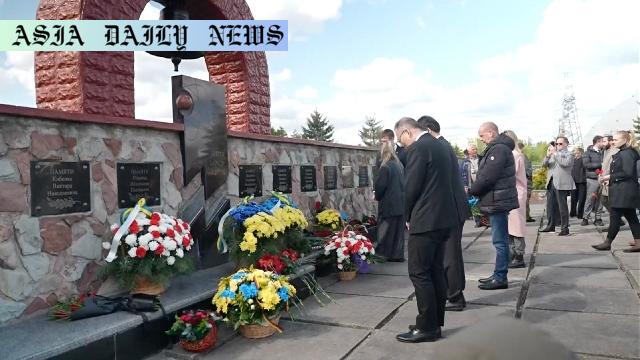Chornobyl disaster remembered during ceremony amidst ongoing conflict.
- Chornobyl disaster marked 39 years since the 1986 nuclear accident.
- Ukraine held commemorative ceremonies amidst ongoing conflict with Russia.
- Concerns raised about Russian threats to nuclear plants after attacks.
- The disaster remains a stark reminder of nuclear safety and its global impact.

Remembering the Tragedy of Chornobyl 39 Years Later
On April 26, 1986, the world witnessed one of the most catastrophic nuclear disasters at the Chornobyl nuclear power plant in northern Ukraine. An explosion at Reactor 4 released a vast amount of radioactive material into the atmosphere, creating a calamity that has left a lasting imprint on human history. The disaster caused between 30 to 50 immediate casualties, most of whom were first responders and firefighters. However, the full scale of the tragedy unfolded over the years, as thousands of people were affected by radiation exposure, leading to chronic health conditions and environmental destruction.
To mark the 39th anniversary, Ukrainians gathered to commemorate those who lost their lives and reflect on the immense cost of nuclear safety failures. Among the attendees were Minister of Environmental Protection and Natural Resource Svitlana Grynchuk and workers at the Chornobyl facility. Ceremonial activities included the laying of flowers at a cenotaph and observing a moment of silence to honor the deceased. These poignant tributes underline the continuing relevance of the disaster in shaping both Ukraine’s history and global discussions on nuclear safety.
The Dual Challenges of Memory and Modern Threats
This year’s ceremony occurred against the backdrop of ongoing conflict between Russia and Ukraine, which has amplified existing fears about nuclear safety in the region. In February, a Russian drone attack targeted a radiation shelter designed to prevent the leakage of radioactive substances, further exacerbating safety concerns. The Ukrainian government condemned the attack as reckless and warned the international community about the potential for another disaster.
A statement from Ukraine’s foreign ministry on the occasion highlighted the gravity of the situation. It accused Russia of pushing the world toward another nuclear catastrophe by targeting critical infrastructure. The ministry’s plea to the international community was clear: collective efforts are required to protect nuclear facilities and prevent similar tragedies. The looming threat underscores the enduring dangers surrounding nuclear power and the profound responsibility of safeguarding it against both natural and human-made hazards.
Lessons from Chornobyl and the Importance of Global Cooperation
The legacy of Chornobyl resonates far beyond Ukraine’s borders. It is a sobering reminder that nuclear disasters can have long-reaching consequences, not only for those in the immediate vicinity but for regions and nations worldwide. The 1986 accident prompted significant international reforms in nuclear safety and protocol changes designed to prevent similar incidents. These measures are critical in maintaining stringent safety standards worldwide.
Nonetheless, the recent challenges facing Ukraine illustrate the fragility of these systems in the face of geopolitical conflicts. The Chornobyl incident—and the recent attacks on Ukraine’s nuclear infrastructure—serve as urgent reminders to renew commitments to global cooperation in nuclear safety oversight. Only through united efforts can we mitigate risks and uphold the principles of responsible nuclear energy use.
Conclusion: Balancing Past Lessons and Future Responsibilities
As Ukraine commemorates 39 years since the Chornobyl disaster, the occasion serves as a call to action for nations, institutions, and individuals worldwide. While the memory of the past continues to inspire caution, the challenges of the present demand preparedness, collaboration, and vigilance. In light of ongoing geopolitical conflicts, the imperative to shield nuclear facilities from harm cannot be overstated. The sacrifices of the past generations who faced the worst of the nuclear tragedy should not be in vain; instead, they must guide our collective efforts to create a safer and more secure future.



Commentary
The Dual Burden of Memory and Conflict
Reflecting on the Chornobyl disaster 39 years later offers not only a moment to remember those who suffered but also a sobering lens to examine present challenges. The nuclear power plant accident in Ukraine is etched indelibly into the annals of history as one of humanity’s darkest lessons in the complexity and danger of modern technology. This memory serves as both a warning and a guidepost in our pursuit of safer and more ethical energy practices.
Why Protecting Nuclear Sites Matters
The ongoing conflict in Ukraine has added a precarious layer of tension to the subject of nuclear safety. Russia’s attack on a radiation shelter earlier this year highlighted the persistent risks that nuclear plants face in zones of unrest. The need for vigilance and international collaboration is more urgent now than ever. Ignoring these vulnerabilities could result in another catastrophe of global proportions, a scenario that no nation can afford to ignore.
A Global Call to Action
The Chornobyl anniversary further reinforces the necessity of collective action. Nuclear safety is not just a regional concern; it is a pressing issue for the entire global community. Advances in technology and energy should be coupled with stringent safeguards that prioritize human lives and environmental health. Moreover, when these safeguards come under threat, as seen in Ukraine, the world must respond rapidly and decisively. Protecting our planet and its people requires unyielding commitment and far-reaching cooperation.